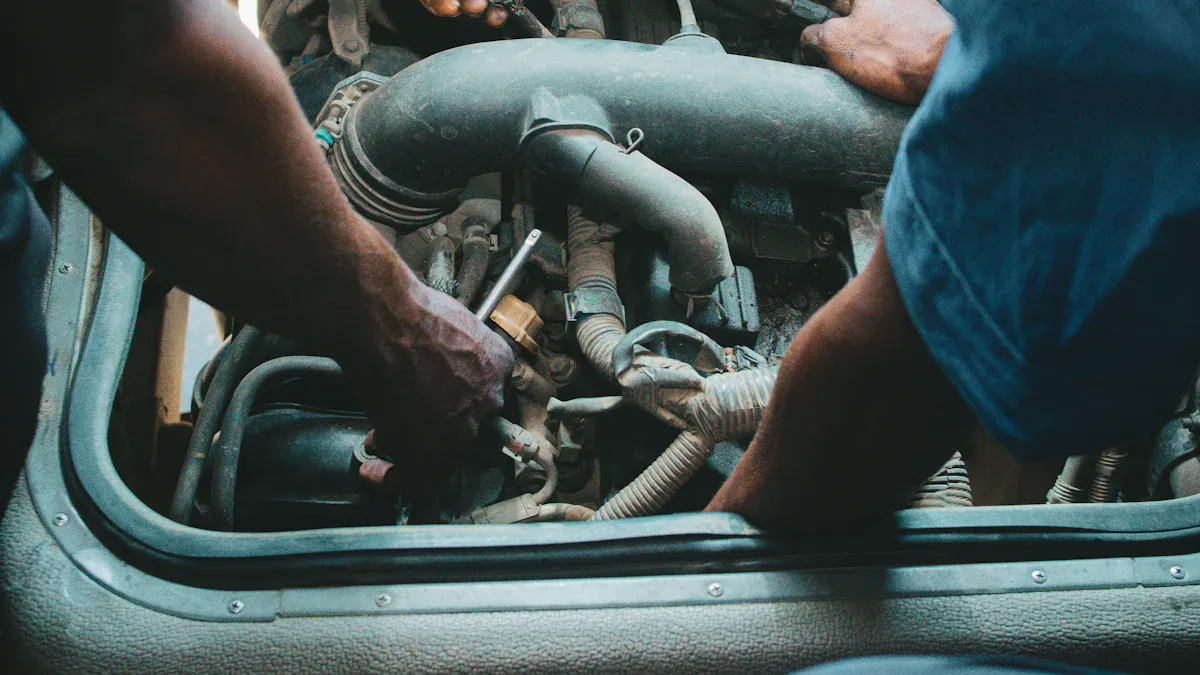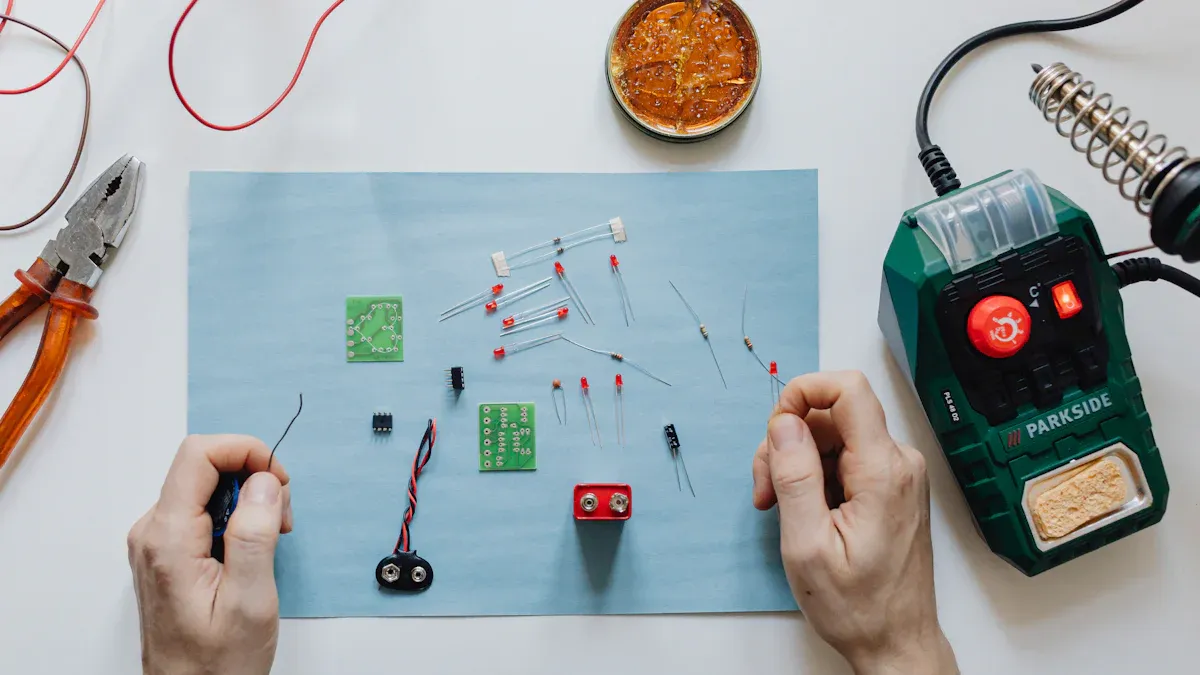
Is your car’s fan stuck on one speed or not working at all? You can fix this problem yourself by changing the Blower Motor Resistor. Grab a few simple tools and follow along. You’ll get your car’s air blowing strong again in no time!
Key Takeaways-
Gather all necessary tools before starting the replacement. This includes a T20 Torx bit, a 10mm socket, and a flashlight to help you see in dark areas.
-
Always disconnect the negative battery terminal for safety. This prevents electrical shorts and protects you from shocks while working.
-
Take a photo of the wiring before unplugging anything. This helps you remember how to reconnect everything correctly after replacing the resistor.

Tools Needed
Before you start, gather all the tools and parts you’ll need. Having everything ready makes the job much smoother. Here’s a handy list to check off:
-
T20 Torx bit (long)
-
10mm deep socket or driver
-
90-degree angle driver or drill with a flex extension (optional, but helpful for tight spots)
-
Hand driver with a hex bit receptacle
You’ll also need a replacement Blower Motor Resistor that fits your car. Double-check the part number before you buy it. If you have a flashlight, keep it close. Some areas under the dash can get pretty dark.
Safety Steps
Safety comes first when you work on your car. You don’t want any surprises while handling electrical parts. Here are some important steps to follow:
-
Always disconnect the negative battery terminal before you begin. This stops any chance of an electrical short.
-
Disconnecting the battery also protects you from accidental shocks while you work with the wiring.
-
Wear gloves if you have them. They help protect your hands from sharp edges and dirt.
-
Keep your tools organized so you don’t lose anything under the seats or dash.
Tip: Take a quick photo of the wiring before you unplug anything. This makes it easier to remember where everything goes when you put it back together.
Taking these steps helps you stay safe and makes the Blower Motor Resistor replacement go smoothly.
Blower Motor Resistor ReplacementRemove Glove Box
You’ll usually find the blower motor resistor behind the glove box. Start by emptying the glove box so nothing falls out. Most glove boxes come out with just a few steps:
-
Open the glove box and look for screws along the top and bottom edges. Some cars hide screws under a rubber mat inside the glove box, so check there too.
-
Remove all visible screws. You might find 5 to 7 screws, depending on your car.
-
If your glove box has a light, disconnect the light harness. Some models also have a trunk lock harness—unplug that as well.
-
Gently slide the glove box out. If it feels stuck, check for any missed screws or clips.
-
In some cars, you may need to pull the door sill trim or remove a kick panel first. Look for a 10mm bolt holding the lower dash panel and remove it if needed.
Tip: Keep all screws and clips in a small container so you don’t lose them.
Access Blower Motor Resistor
With the glove box out, you’ll see the blower motor and the resistor nearby. The resistor usually sits close to the blower motor, held in place by two screws. Use your flashlight to spot it. If you see a small rectangular part with a wire connector, you’ve found it.
Disconnect Wiring
Before you remove the resistor, take a quick photo of the wiring. This helps you remember where each wire goes. Carefully press the tab on the connector and pull it straight out. Don’t yank the wires—wiggle the connector gently if it feels stuck.
-
Only one speed from the blower motor? Or maybe no air comes from the vents? These are signs the resistor is faulty and needs to come out.
Remove Old Resistor
Now, grab your Torx bit or socket and remove the screws holding the resistor in place. Set the screws aside. Pull the old resistor out. Sometimes it sticks, so wiggle it gently if needed.
Note: Double-check that you’re removing the right part. If you’re not sure, test the wires with a multimeter before taking out the resistor.
Install Blower Motor Resistor
Take your new blower motor resistor and line it up with the mounting holes. The orientation isn’t critical, but make sure the connector is easy to reach for future repairs. Here’s a quick table to help you remember:
|
Key Point |
Description |
|---|---|
|
Orientation |
Not critical for installation |
|
Connector |
Should be easy to access for future maintenance |
|
Facing Direction |
Doesn’t matter if facing seat or firewall |
Slide the new resistor into place and secure it with the screws. Tighten them so the resistor sits firmly, but don’t over-tighten. Plug the wiring connector back in until it clicks.
Make sure the new resistor is seated properly and the connector is fully attached. Loose connections can cause the fan to stop working again.
Reassemble Glove Box
Now, slide the glove box back into position. Reconnect any harnesses you unplugged earlier, like the light or trunk lock. Replace all screws and tighten them. If you removed any panels or trim, snap them back into place.
Reconnect Battery
You’re almost done! Head to the battery and get ready to reconnect it:
-
Clean the battery terminals with a wire brush if they look dirty.
-
Place the battery securely in its spot.
-
Connect the positive terminal first, then the negative terminal.
-
Secure the battery with its clamp or bracket.
-
Reinstall any covers or parts you removed to reach the battery.
-
Check that everything is tight and secure.
Always connect the positive terminal before the negative. This helps prevent sparks and keeps you safe.
You’ve finished the job! Before you close the hood, turn on your car and test the fan at all speeds. If everything works, you’ve replaced the blower motor resistor like a pro.
Test and Troubleshoot
Test Fan Speeds
Now that you have everything back together, it’s time to check your work. You want to make sure your fan works at every speed. Here’s a simple way to test each part of the system:
-
Turn your car key to the "On" position. Set the fan to the lowest speed and listen for the blower. Move the switch through each speed and check if the fan changes speed each time.
-
If you want to dig deeper, grab a digital multimeter. Check the voltage between the brown and red wires at the blower motor. You should see 12 to 14 volts.
-
Next, test the control module. With the key on, measure the voltage between the brown and white/pink wires. Try this at each fan speed setting.
-
If the fan still doesn’t work, remove the resistor pack. Use a DC power supply to test the blower motor directly. It should run at full speed.
-
Finally, reconnect the fan’s wires to the resistor pack. Use the power supply again and see if the fan works at all speeds.
If you hear the fan at every speed, you’ve installed the Blower Motor Resistor correctly!
Troubleshooting Tips
Sometimes things don’t go as planned. If your fan still acts up, try these quick checks:
-
Double-check all wiring connections. Loose plugs can stop the fan from working.
-
Make sure the new resistor is seated firmly in its slot.
-
Look for blown fuses in your car’s fuse box.
-
If the fan only works on the highest speed, the resistor may not be getting power or could be faulty.
-
Use your multimeter to test for voltage at the blower motor and resistor pack.
|
Problem |
Possible Cause |
Quick Fix |
|---|---|---|
|
Fan doesn’t work at any speed |
Loose wire, blown fuse |
Check connections, fuses |
|
Only high speed works |
Faulty resistor |
Replace resistor |
|
Fan works, but noisy |
Debris in blower motor |
Clean out motor area |
Don’t get discouraged! Most issues come from simple mistakes. Take your time and check each step.
You just tackled a big job! Here’s a quick checklist to keep your car’s fan running strong:
-
Replace the cabin air filter on schedule and check for leaves or debris.
-
Make sure the resistor sits fully in the duct.
-
Test every fan speed and double-check all connections.
-
Got questions or trouble? Drop a comment below!
How do I know if my blower motor resistor is bad?
You might notice your fan only works on one speed or not at all. That’s a common sign the resistor needs replacing.
Tip: If the fan only blows on high, check the resistor first!
Can I drive my car if the blower motor resistor is broken?
You can drive, but you won’t have control over your fan speeds. That means less comfort and poor defrosting in cold weather.
Do I need special tools for this job?
Nope! You just need basic hand tools like a Torx bit and a socket. A flashlight helps you see under the dash.

